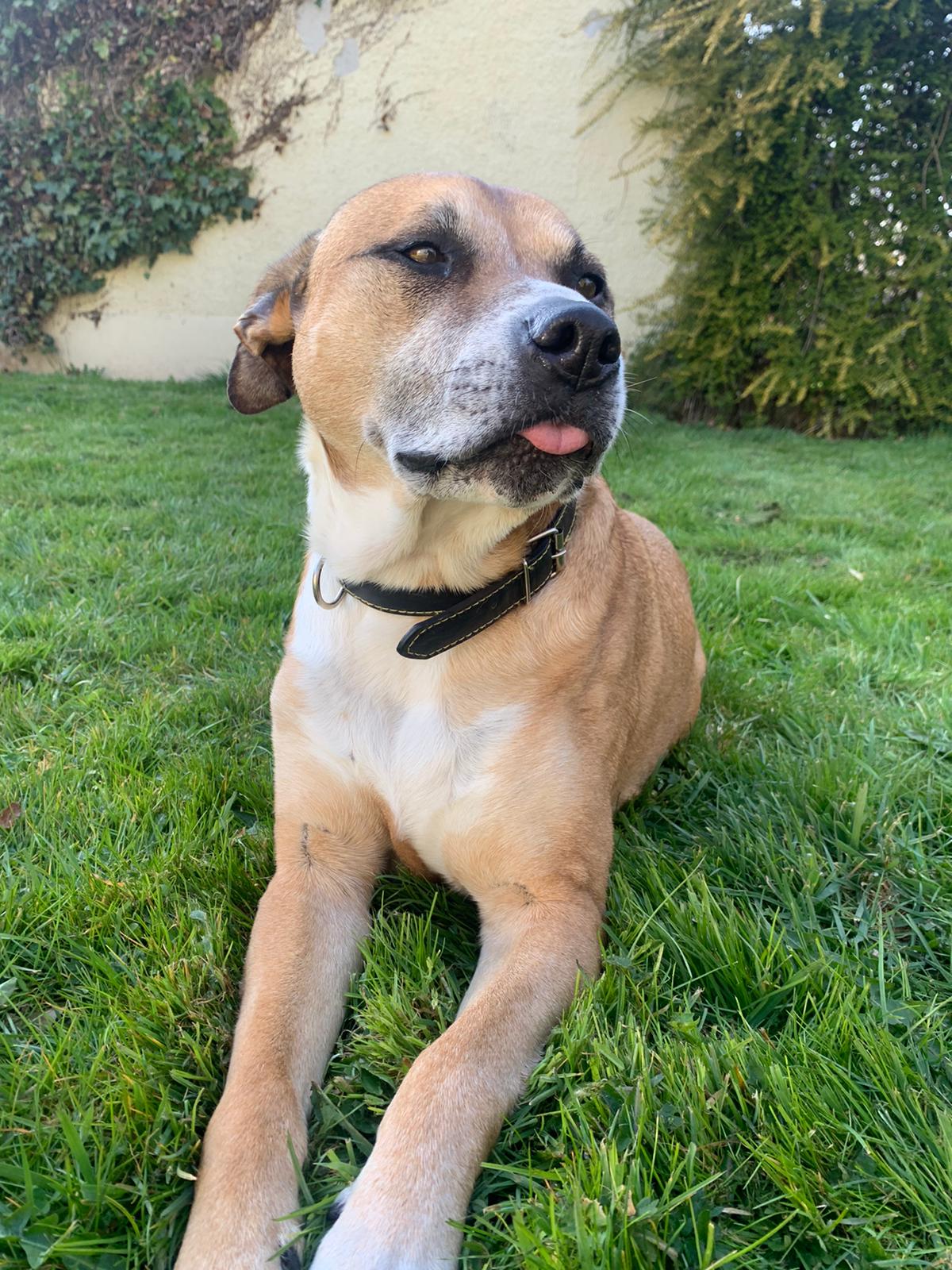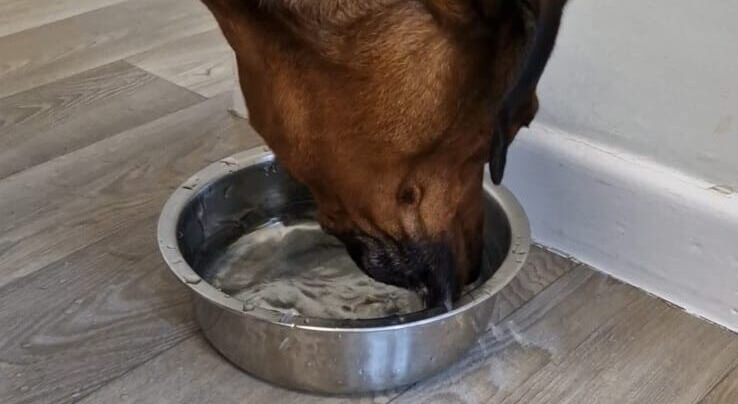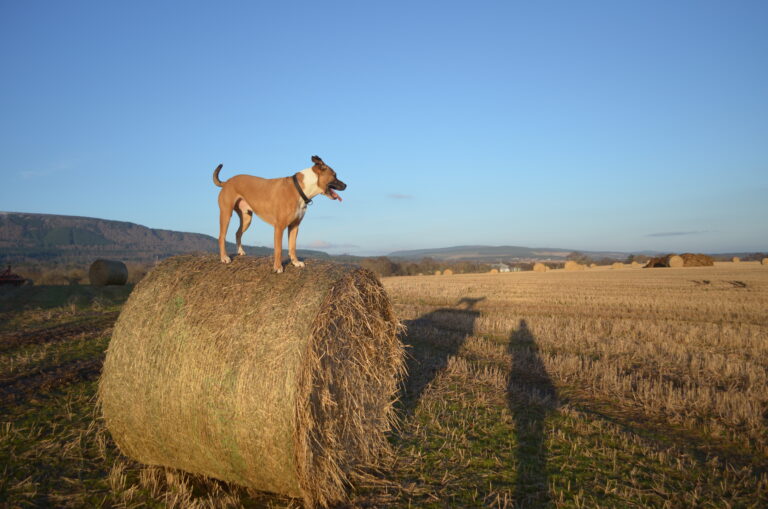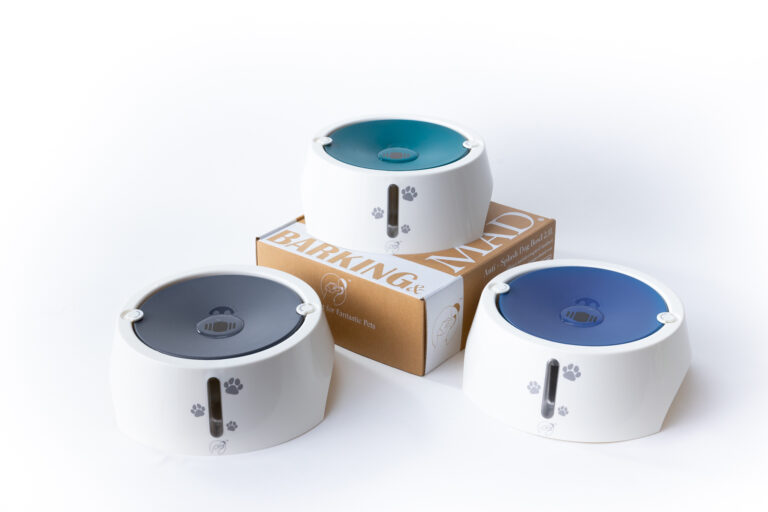Ever wondered why your dog gets restless or starts chewing on everything? It’s not just physical energy – they need mental stimulation too!
I found that Snippet my Lurcher was very excitable, especially when he was a puppy. It was good I was creative.
Training games for dogs are the key to a happy pet, Snippet lit up like a Christmas tree when he solved puzzles or play fetch with a twist or sniff out hidden treats. Let’s get into the best training games to turn your daily routine into an adventure, keep their brain sharp and their tail wagging.
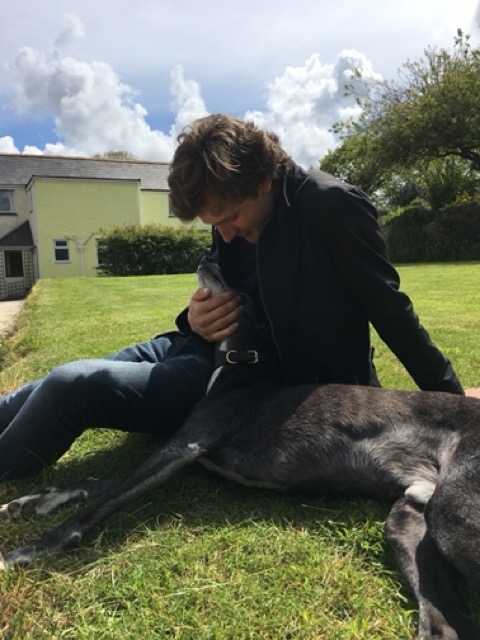
Why Games?
Games are a great way to boost obedience, fun and mental stimulation for dogs. They make learning fun for dogs and owners, what could be a chore into a bonding experience. Imagine playing hide and seek with your dog; not only is it fun but it also strengthens your bond, trust and teamwork. Games are play and training in one, so your dog stays mentally stimulated and obedient.
Strengthen Your Bond: Playing with your dog builds a stronger bond. When you play together you’re not just training, you’re spending quality time with your pet which strengthens your relationship.
Learning Through Fun: Dogs learn best when they’re having fun. Training games makes learning fun, so they retain commands and skills better.
Reduces Behavioral Problems: Many behavioral problems in dogs are caused by boredom and lack of mental stimulation. Training games keeps your dog’s brain active, reduces the likelihood of destructive behaviors like chewing and digging.
Benefits
Training games aren’t just a fun way to kill time; they’re good for your dog’s overall health. Imagine your dog navigating an obstacle course, their powerful sense of smell leading them to hidden treats or using problem solving skills to learn a new trick.
Boosts Problem Solving: Games like treasure hunt are great for exercising your dog’s brain. As they figure out how to get treats out of cardboard boxes, their problem solving skills improve big time.
Obedience and Impulse Control: Games like tug of war or loose leash walking teaches your dog self control. They’ll learn to follow commands and stay focused even with all the distractions around.
Physical Exercise: Many training games like fetch or obstacle courses combines physical and mental stimulation. This dual approach burns off excess energy, keeps your dog fit and healthy.
Socialization: Games that involves other dogs or new environments can improve your dog’s social skills. Whether it’s playing hide and seek with you or joining a group for a green light game, your dog will learn to interact positively with others.
Reduces Anxiety and Boredom: Mentally stimulating activities reduces anxiety and prevents destructive behaviors. When your dog’s brain is working they’re less likely to chew the furniture or dig holes in the yard.
Overall Well-being: Regular mental exercise leads to overall well-being. Mentally stimulated dogs are happier and healthier, means better quality of life.
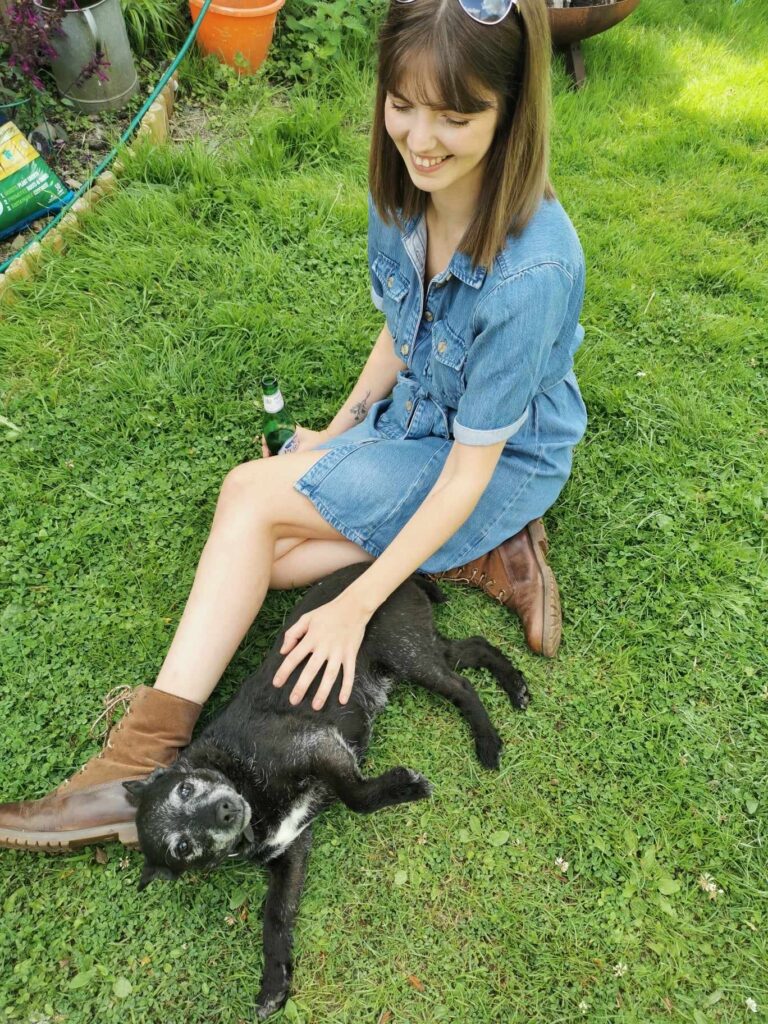
Brain Games for Dogs
Brain games are a great way to provide mental stimulation for dogs, challenging their problem solving skills and keeps them engaged. Examples of brain games for dogs are hide and seek, puzzle toys and scent work.
These activities reduces stress and anxiety, promotes a happier and healthier life. Imagine your dog using their powerful nose to find treats around the house or solving a puzzle toy to get to their favorite snack.
Hide and Seek
Hide and seek is a classic game that dogs love. It’s a great way to mentally stimulate your dog and keep them engaged.
Start by hiding in a low distraction environment and call your dog. When they find you, reward them with a high value treat or their favorite toy. Gradually increase the difficulty by hiding in more challenging spots or having other family members hide as well.
Puzzle Toys
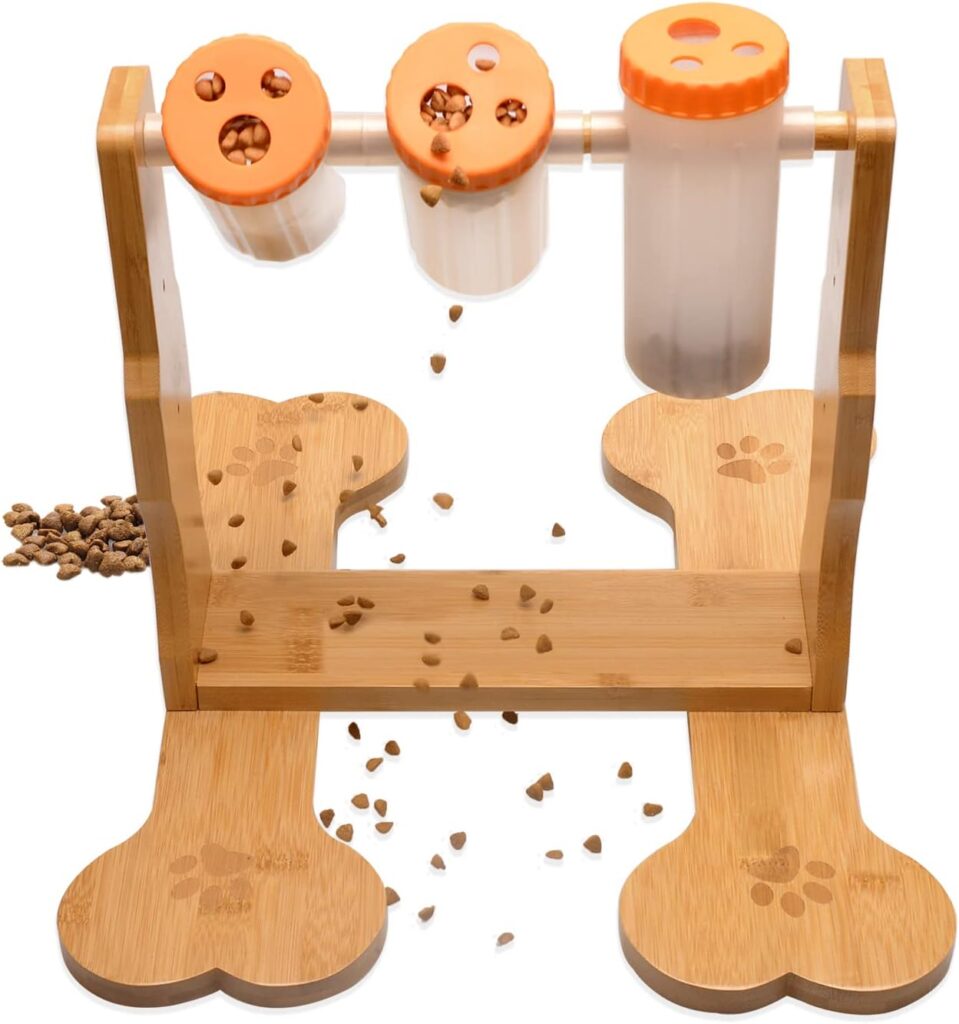
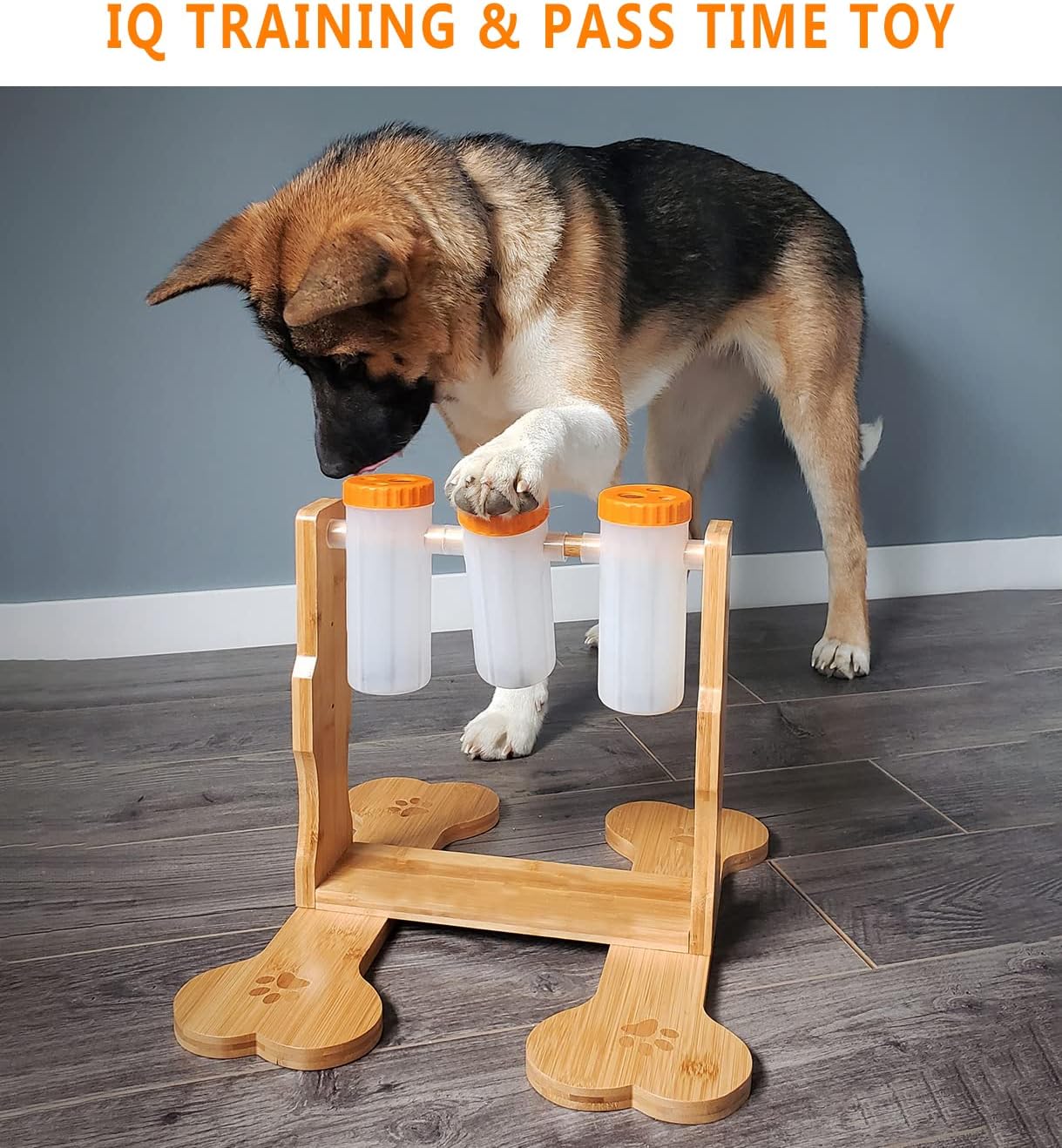
PICK FOR LIFE Dog Puzzle Toy
This dog puzzle toy is designed to provide a challenge to keep your pets thinking. For puppies, the brain game is a good intellectual development toy, which is a smart toy for puppy brain development.
For senior dogs, the mental stimulation toys help to keep your dog sharp through the years, reduce the risk of mental decline.
Puzzle toys are great for exercising your dog’s brain. These toys comes in various shapes and sizes, each designed to challenge your dog’s problem solving skills.
Fill them with high value treats and watch as your dog figure out how to get to their reward. It’s a fun game that can keep your dog occupied for hours, reduces stress and anxiety.
Scent Work
Scent work uses your dog’s natural instincts. Start with a simple game of “find the treat”. Hide treats around the house or yard and encourage your dog to sniff them out. This game requires focus and uses your dog’s powerful nose, provides great mental stimulation.
Obstacle Course
Create an obstacle course in your backyard or living room is a fun way to combine physical exercise with mental stimulation. Use household items like chairs, boxes and pillows to create tunnels, jumps and weaving paths. Guide your dog through the course, reward them with treats and praise. It’s a great game for dogs of all ages and improves their coordination and agility.
Tug of War
Tug of war is not just a physical game; it also teaches your dog impulse control. Use a sturdy rope toy and play gently, make sure your dog knows the rules. Teach them a release cue like “drop it” and reward them when they drop it on command. This game strengthens your bond and provides mental and physical exercise.
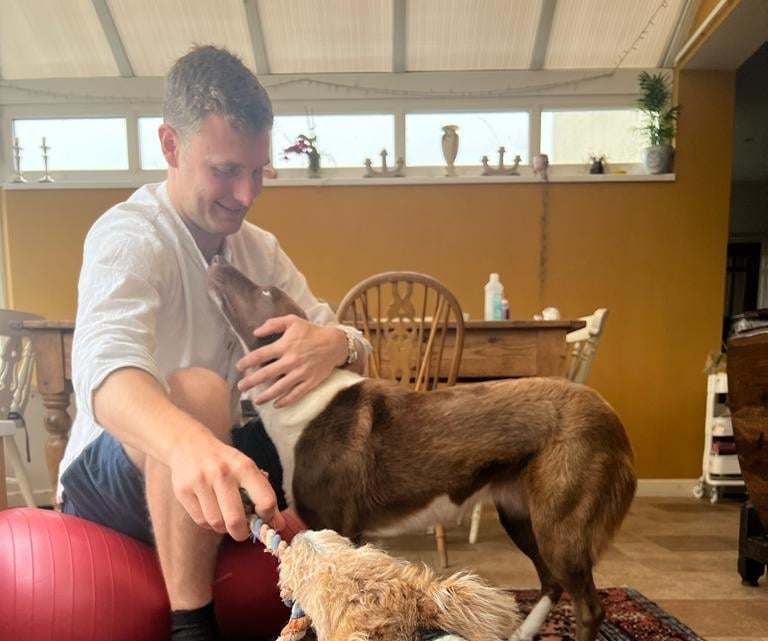
The Shell Game
The shell game also known as three cups game is a great way to test your dog’s problem solving skills. Place three cups upside down and hide a treat under one. Shuffle the cups and ask your dog to find the treat. This game requires focus and sharpens their problem solving skills. (And some plastic cups)
Snuffle Mat
This was a fun one I did, Its a great tool for mental stimulation. Hide treats within the folds of the mat and let your dog sniff them out. This game is a fun and engaging way for your dog to use their natural foraging instinct.
Treat Dispensing Toys
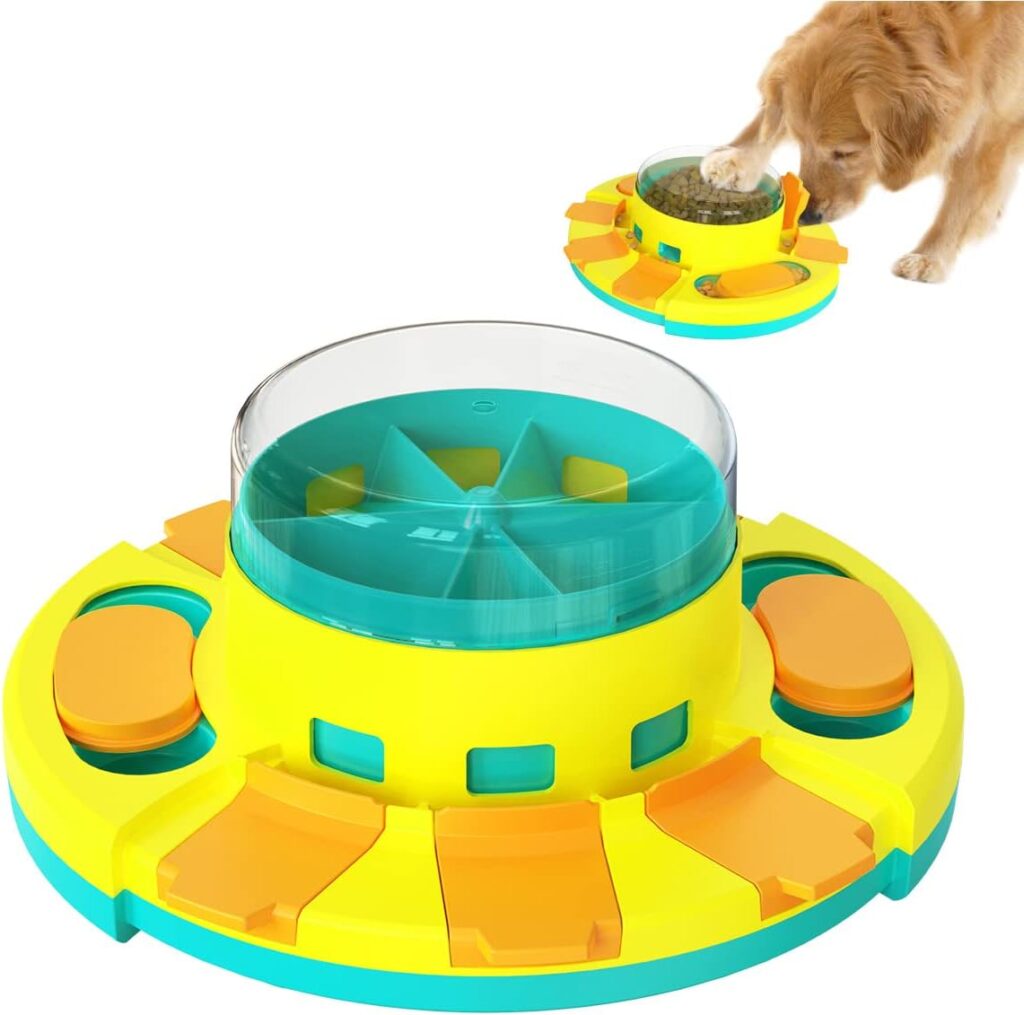
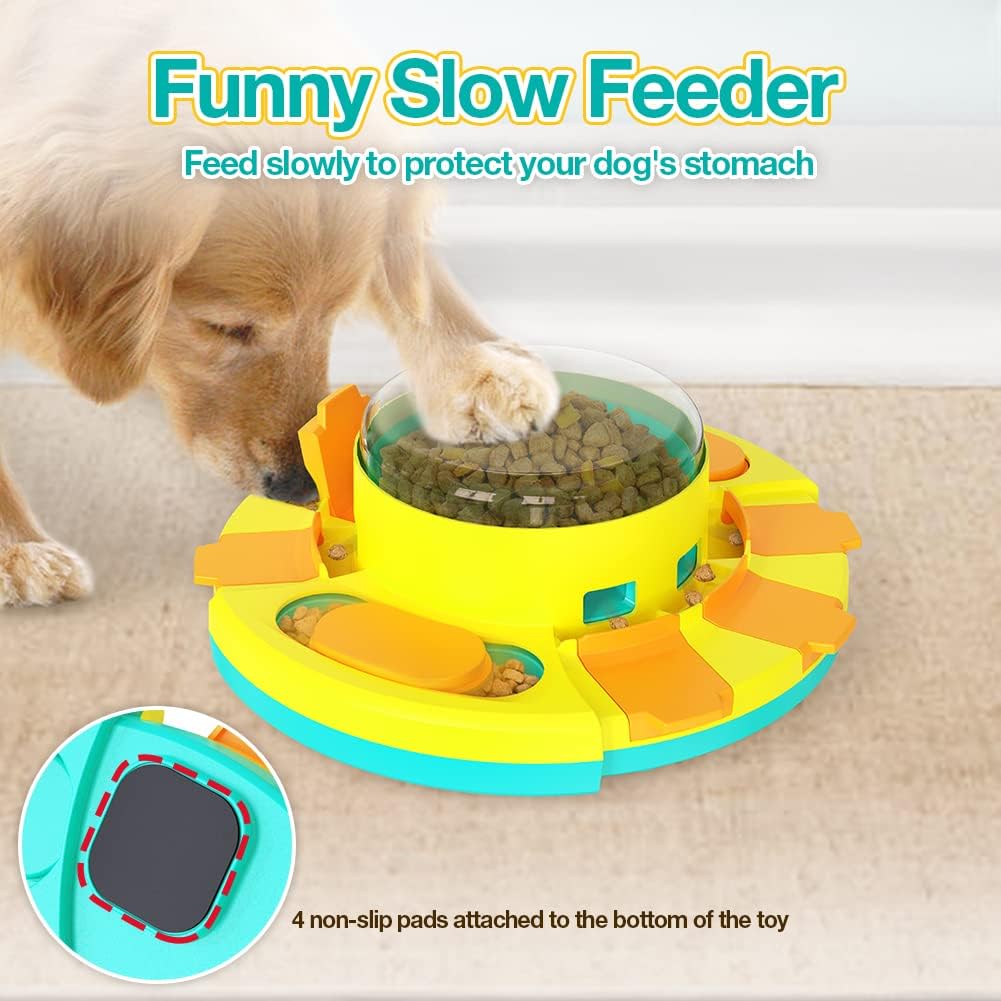
TENGDEE Dog Puzzle Toy
This is a multifunctional dog puzzle toy that integrates functions such as pressing feeding and intelligent feeding. It can help complete brain development of dogs while in playing, exercising dogs thinking ability and promoting their brain development.
Treat dispensing toys are designed to keep your dog occupied and mentally stimulated. Fill the toy with your dog’s favorite treats and let them figure out how to get the treats out. These toys comes in various difficulty levels so you can adjust the challenge as your dog learns.
Frozen Treats
Frozen treats is a great way to keep your dog entertained and mentally stimulated. Fill a Kong toy with peanut butter or yogurt and freeze it. Your dog will spend a lot of time licking and chewing to get to the treat, provides mental and physical exercise.
Treat Puzzle Boards
Treat puzzle boards comes in various design and complexity, challenge your dog to slide, flip and lift pieces to get to the hidden treats. These puzzles will engage your dog’s brain and keep them busy for hours.
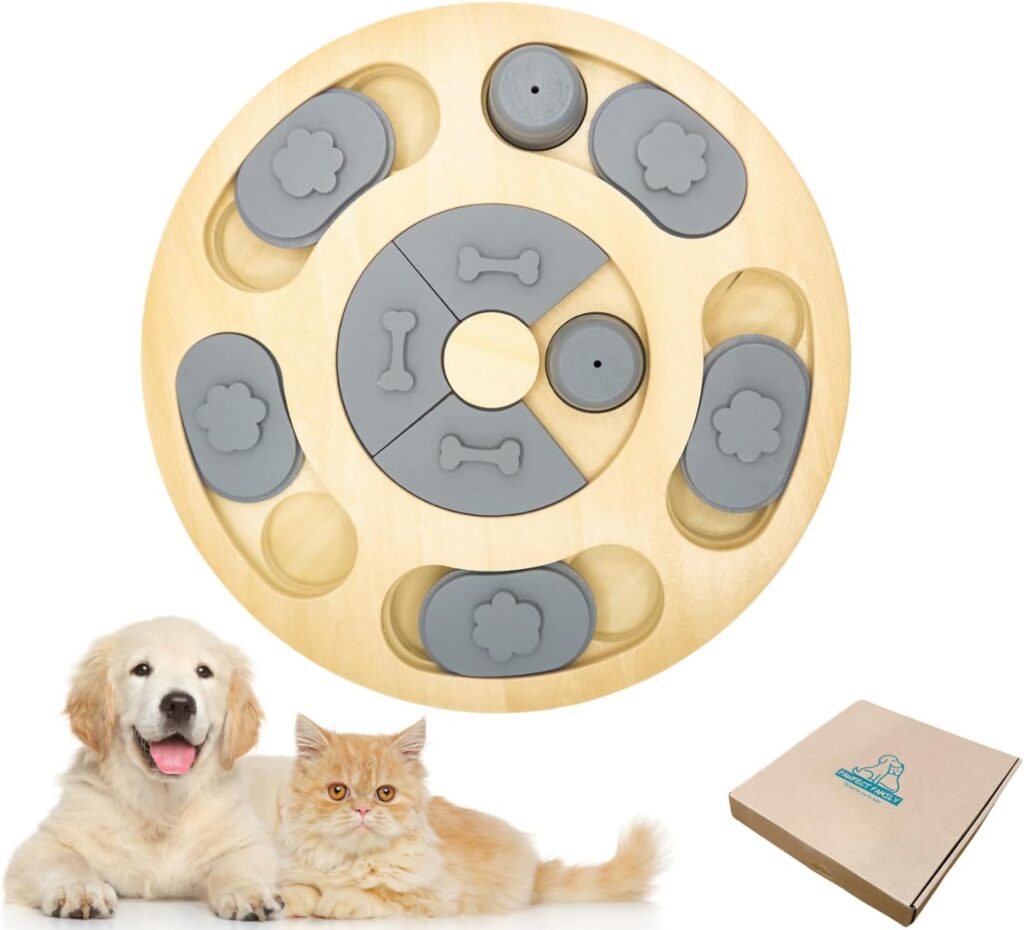
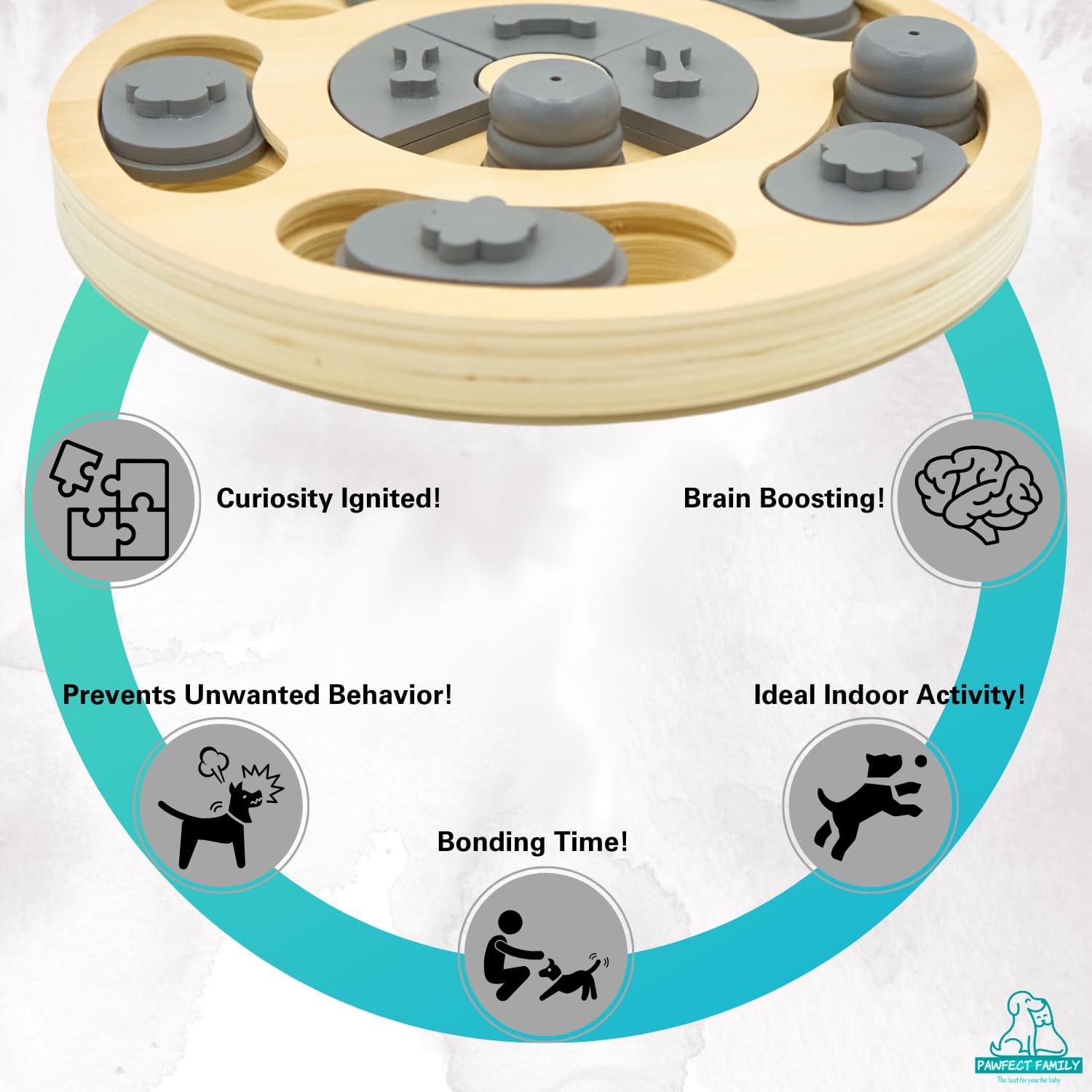
Pawfect Family® interactive toy for dogs
Keep your pet’s boredom at bay with this captivating search game. Featuring two lift-up cones and eight sliding parts, it requires your pet to use their paw and nose to discover hidden treats. Watch as their determination and curiosity soar!
DIY Foraging Box
Create a DIY foraging box using a cardboard box filled with crumpled paper, toys and treats. Your dog will have to dig through the box to find the hidden goodies. This activity stimulates their natural foraging instinct and provides mental enrichment.
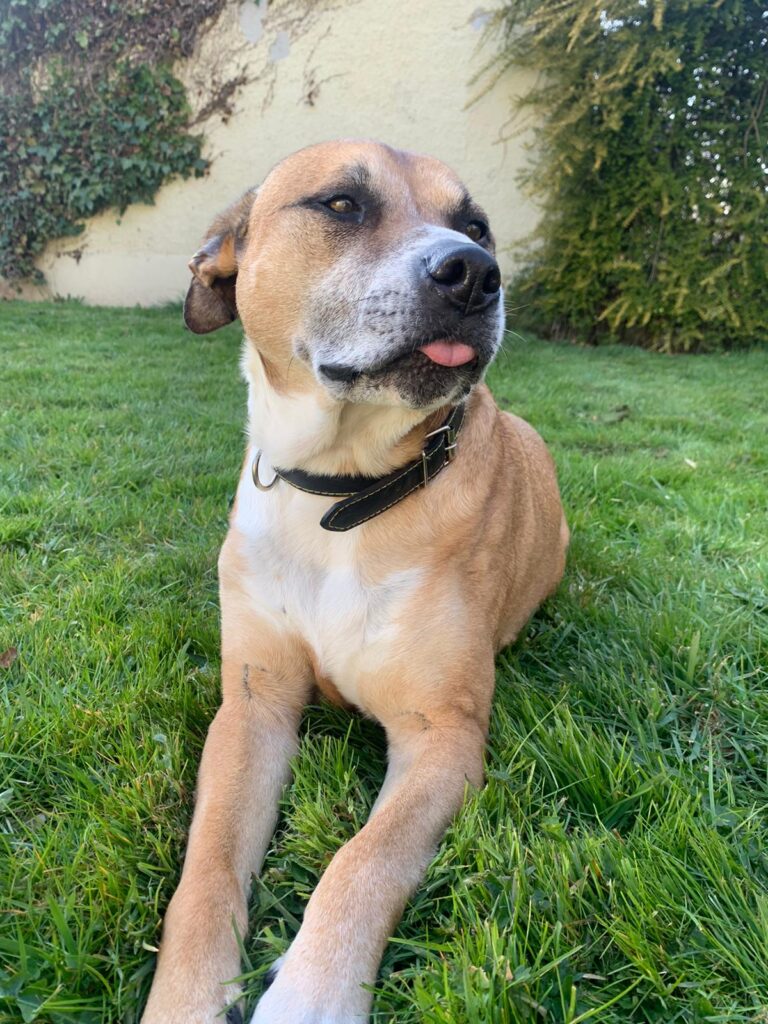
Obedience Training Games
Basic Obedience Skills
Basic obedience skills like sit, stay and come can be taught through fun and interactive games. Games like “Simon Says” and “Red Light, Green Lights” will teach your dog to listen and respond to commands. Use positive reinforcement like treats and praise and your dog will learn fast and effectively.
Simon Says
This game is a fun way to reinforce basic commands. Start with simple commands like “sit” or “stay” and gradually increase the difficulty. Reward your dog with treats and praise for each correct command. This game improves listening skills and will help your dog focus on you.
Red Light, Green Light
Another great game for obedience training is “Red Light, Green Lights”. This game teaches impulse control and commands like “stay” and “come”. Start with your dog in a stay position and use a release cue like “green lights” to let them come towards you. Use “red light” to stop them midway. Reward them for following the commands correctly.
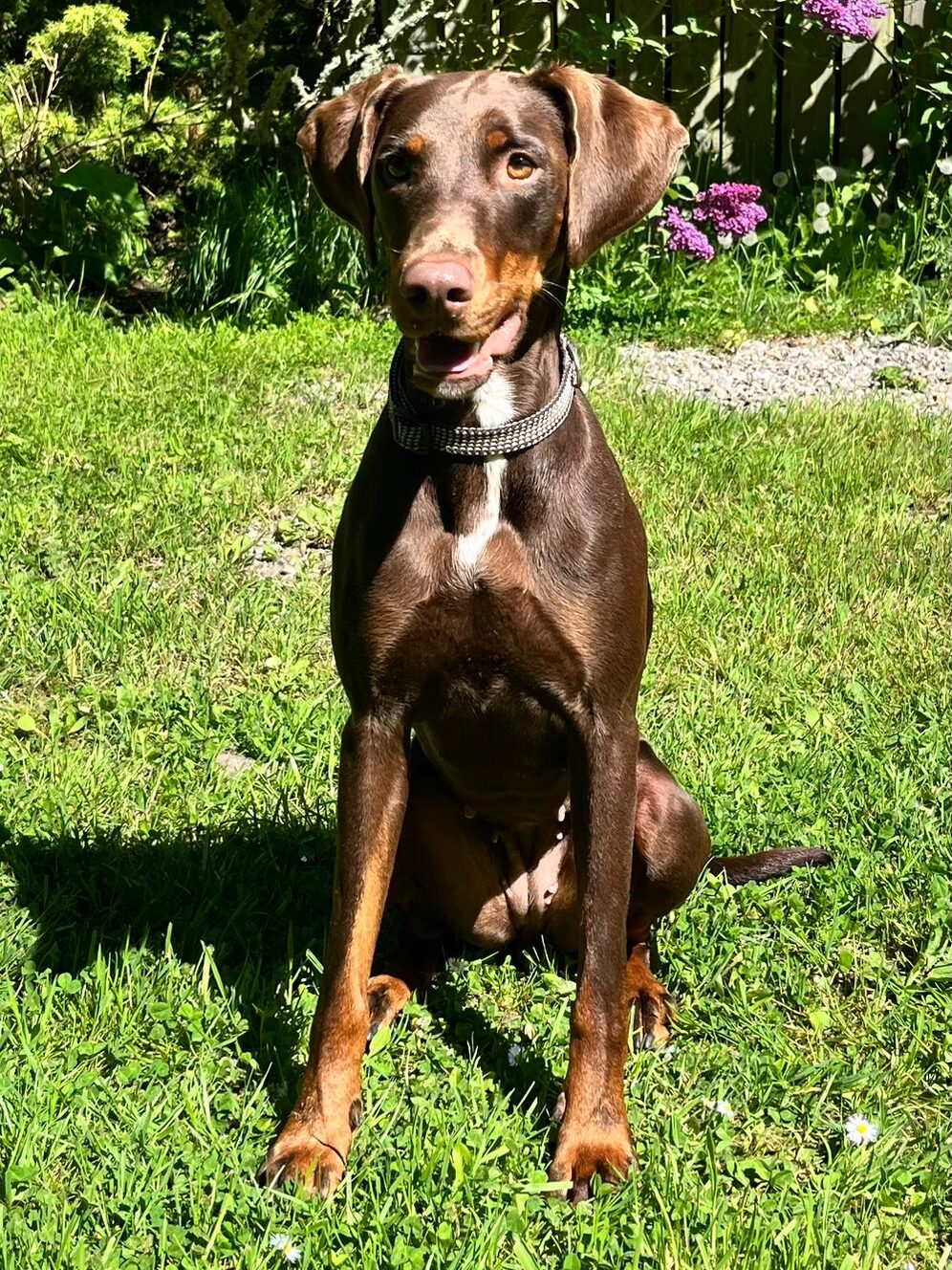
Advanced Obedience Training
Advanced obedience training can be achieved through games that challenge your dog to think critically and problem solve. Games like “Figure-Eights” and “Weave Through Cones” will develop their agility and coordination. Using verbal cues and hand signals, your dog will learn to respond to commands in different situations and become more obedient and adaptable.
Figure-Eights
Set up cones or objects in a figure-eight pattern. Guide your dog through the pattern using treats and verbal cues. This game develops coordination and agility and reinforces obedience commands.
Weave Through Cones
Similar to figure-eights, this game involves setting up cones or objects in a line. Teach your dog to weave through the cones using treats and praise. This game develops agility and obedience.
Stay Commands
Practicing stay commands is part of obedience training. Use a release cue to let your dog know when they can move. Gradually increase the time and distance of the stay command and reward them for staying. This game will improve their self control and obedience.
Recall Games
Recall games are important to teach your dog to come when called. Use a long leash and practice calling your dog from different distances and environments. Reward them with treats and praise when they come to you. This game will make your dog respond to recall commands reliably.
Impulse Control Games
Impulse control games will teach your dog to calm down and wait for your cue. One example is the “It’s Your Choice” game. Hold a treat in your closed hand and only open it when your dog stops trying to get it. This game teaches patience and self control.
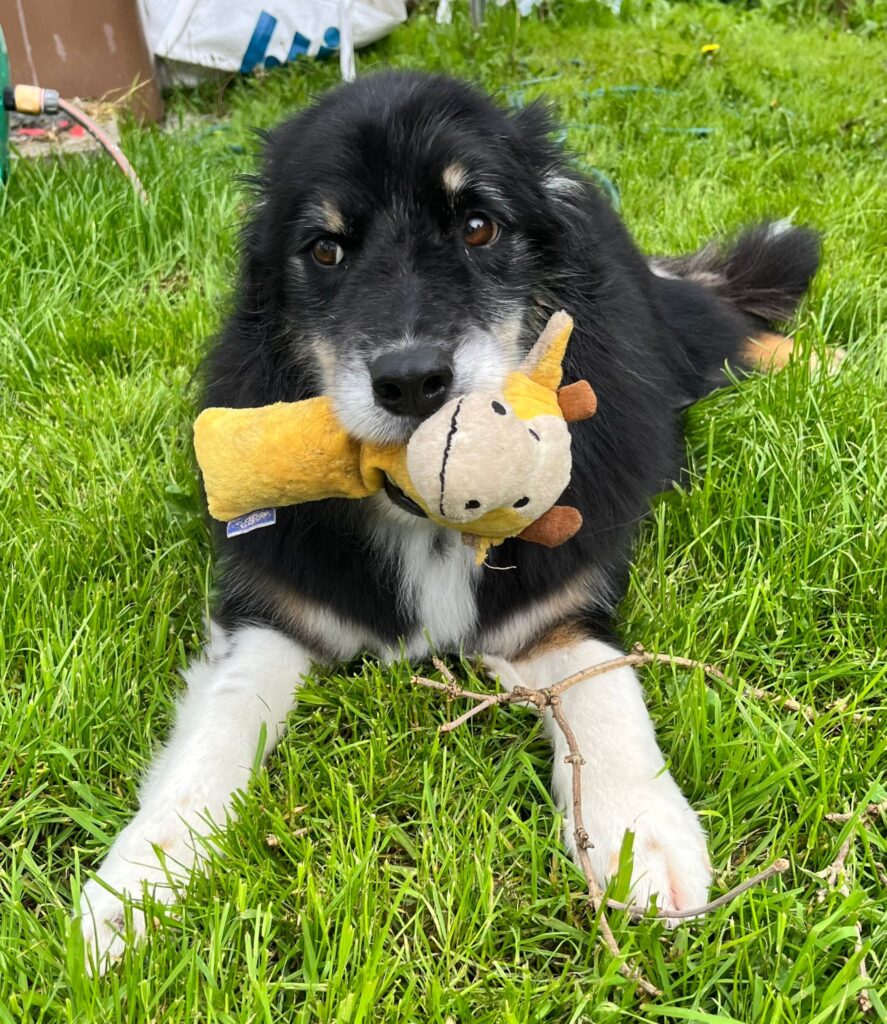
Training with Distractions
To train your dog in different situations, practice commands in different environments with distractions. Start in a low distraction environment and gradually increase the difficulty. This will help your dog learn to focus and respond to commands regardless of the surroundings.
Place Command
Teach your dog the “place” command by designating an area, like a mat or dog bed. Encourage your dog to go to their place and stay there until released. This game develops impulse control and provides a safe space for your dog to chill.
Paw Targeting
Teach your dog to touch a target with their paw. Use a target stick or a piece of tape on the floor. This game develops focus and coordination and is a fun trick to show off to your friends.
Fetch with Commands
Combine fetch with obedience commands. Before throwing the ball ask your dog to do a command like “sit” or “down”. This will reinforce obedience and keep your dog engaged in learning while playing.
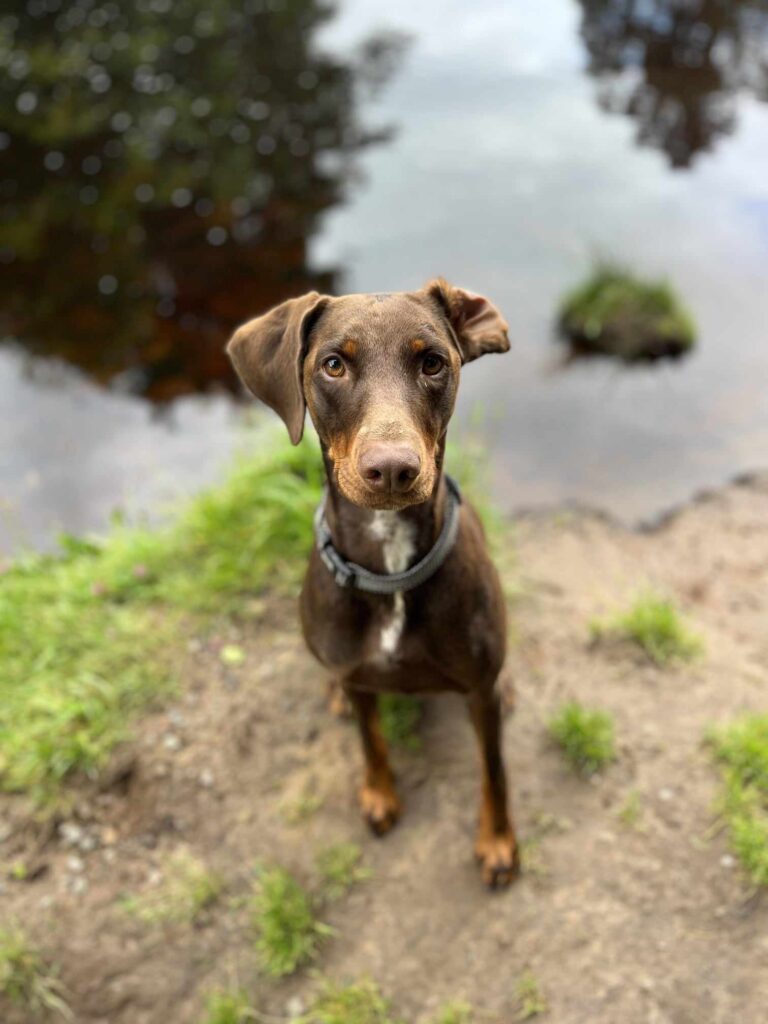
Tug and Release
Play tug of war with your dog but include the command “release”. This will teach your dog to let go of the toy on command and improve impulse control during playtime.
Fun and Interactive Games
Indoor Games
Indoor games like hide and seek and indoor obstacle courses will give your dog physical exercise and mental stimulation. Using household items like cardboard boxes and paper bags will create a fun and challenging environment for your dog. Perfect for rainy days or areas with limited outdoor space.
Hide and Seek with Toys
Instead of hiding yourself, hide your dog’s favorite toys around the house. Encourage your dog to find them using their super power sense of smell. This game will give a good exercise and keep your dog entertained.
Indoor Obstacle Course
Use items like chairs, cushions and blankets to create a mini obstacle course. Guide your dog through the course using treats and praise as rewards. This game will give physical and mental exercises indoors.
Find the dog Toys
Hide your dog’s favorite toy under a blanket or behind some furniture. Encourage your dog to use their nose and brain to find the hidden toy. This game will keep them engaged and sharpen their problem solving skills.
Interactive Treat Puzzle
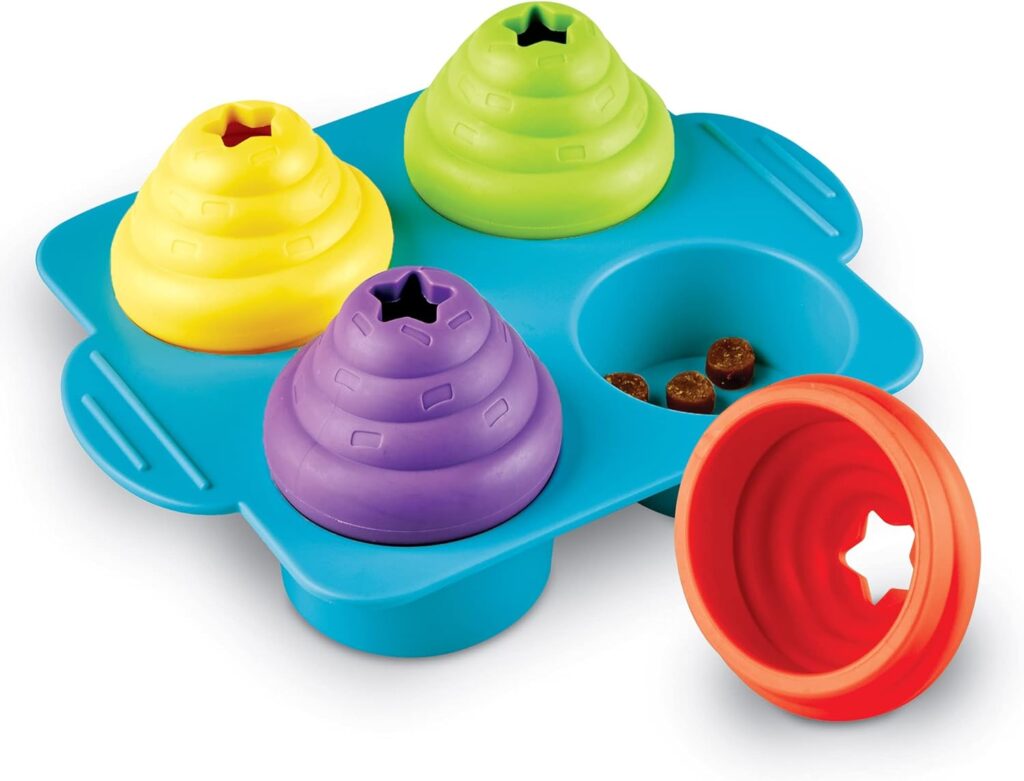
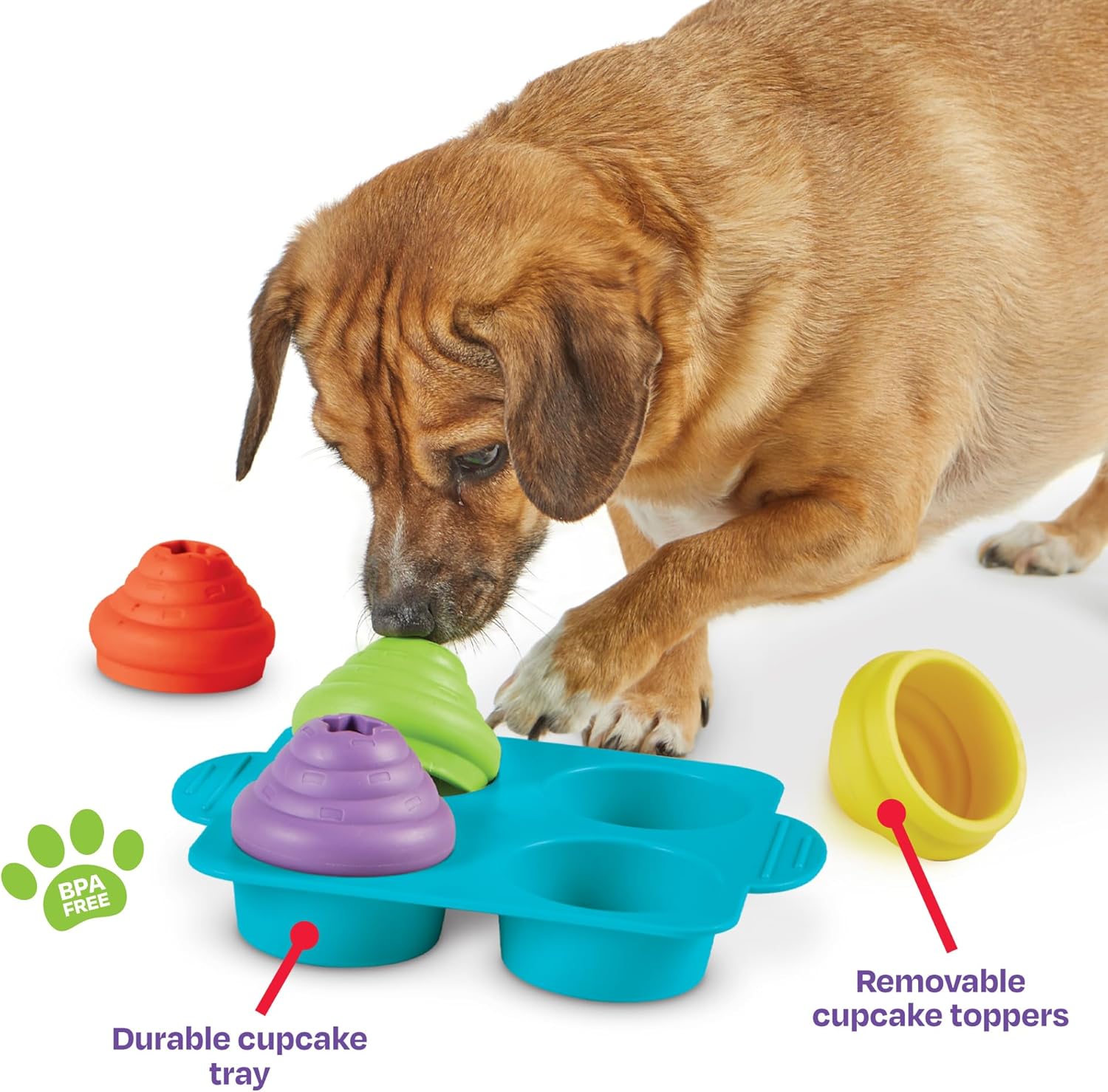
Brightkins Cupcake Party!
Place treats or kibble in the tray cups, cover with the cupcake frosting toppers, and encourage your dog to use its nose and paws to find the treats inside
Use a muffin tin game and tennis balls to create an interactive treat puzzle. Place treats in some of the muffin tin cups and cover them with tennis balls. Let your dog figure out how to move the balls to get to the treats. This game will require problem solving and mental stimulation.
DIY Sensory Box
Fill a box with different textured items like crumpled paper, fabric and plastic bottles. Hide treats or toys among the items. This sensory box will encourage exploration and keep your dog’s mind active.
Treasure Hunt with Clues
Create a treasure hunt with a series of clues leading to the final prize. Use simple commands or actions your dog needs to do to find the next clue. This game will engage their brain and be an adventure.
Bubble Chasing
Blow bubbles and let your dog chase and pop them. This game will give physical exercise and mental stimulation. Make sure to use pet-safe bubbles for this activity.
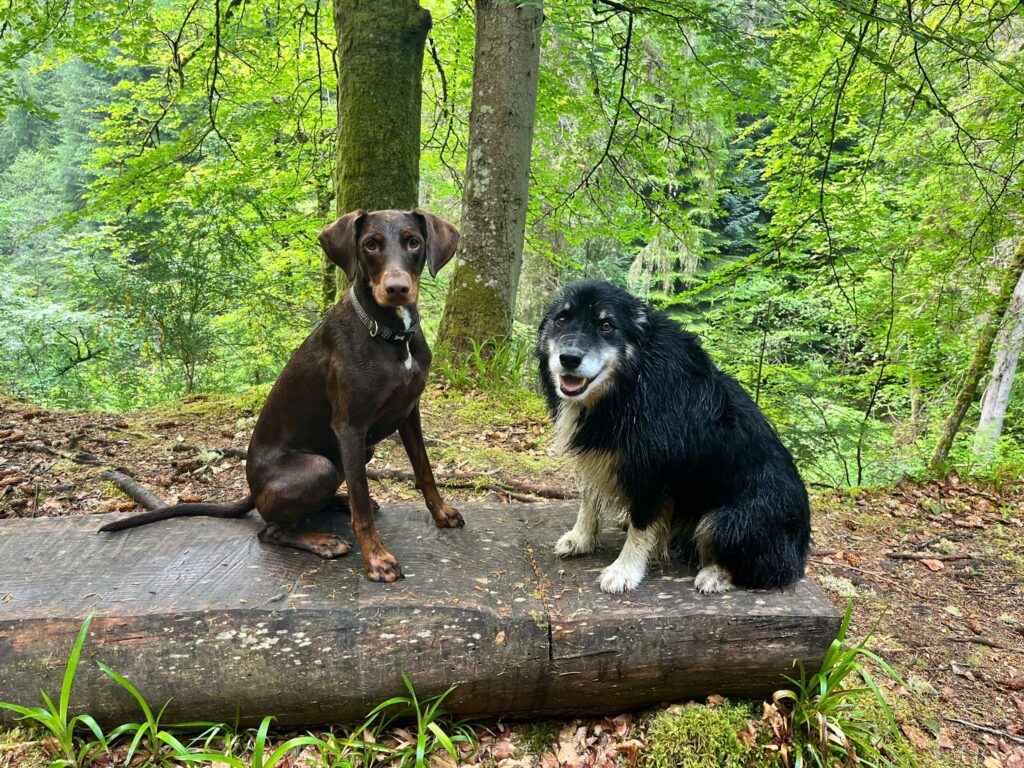
Name the Toy
Teach your dog the names of their toys. Start with two toys and name each one. Ask your dog to fetch the correct toy by saying its name. This game will improve their listening skills and cognitive abilities.
Laser Pointer Chase
Use a laser pointer to create a moving target for your dog to chase. This game is great for indoor exercise and will keep your dog engaged with new skills. Don’t shine the laser directly into your dog’s eyes.
Sniff and Find
A fun game to play is to hide treats in different rooms of your house and let your dog sniff them out. This game will use their sense of smell and give mental stimulation as they search for the treats.
Outdoor games like fetch and agility training will give dogs physical exercise and mental stimulation. Using outdoor equipment like tunnels and jumps will create a fun and challenging environment for dogs. Outdoor games can be played in parks, backyards or other open areas so it’s great for burning off excess energy and keeping your dog fit.
Add a twist to the classic game of fetch by using different objects like tennis balls or favorite toys. You can also add commands like “sit” or “stay” before throwing the ball. This game will keep your dog physically active and mentally engaged.
Set up an agility course in your backyard using tunnels, jumps and weave poles. Guide your dog through the course using treats and praise. This game will give excellent physical exercise and mental stimulation and will improve your dog’s agility and obedience.
Create a treasure hunt in your yard by hiding treats or toys in different spots. Ask your dog to use their nose to find the hidden treasures. This game will give mental stimulation and will tap into their foraging instinct.
Play tag with your dog by running around your yard or a park. Use commands like “come” and “stay” to add training to the game. This will give physical exercise and will reinforce obedience commands in a fun way.
If your dog loves water, add water games to their daily routine. Set up a kiddie pool and let your dog splash around or fetch floating toys. Water games are perfect for hot days and will keep your dog cool and active.
Fetch with Obstacles
Set up small obstacles like cones or hurdles in your yard. Throw the ball and let your dog go through or over the obstacles to get it. This will add an extra challenge to the game of fetch.
Play with Other Dogs
Arrange playdates with other dogs to socialize and physically exercise. Playing with other dogs will give mental stimulation and will teach your dog social cues and behaviors.
Nature Walks with Challenges
Take your dog on nature walks and add challenges like climbing over logs, walking on different surfaces or practicing commands. This will be a stimulating environment and will keep your dog engaged.
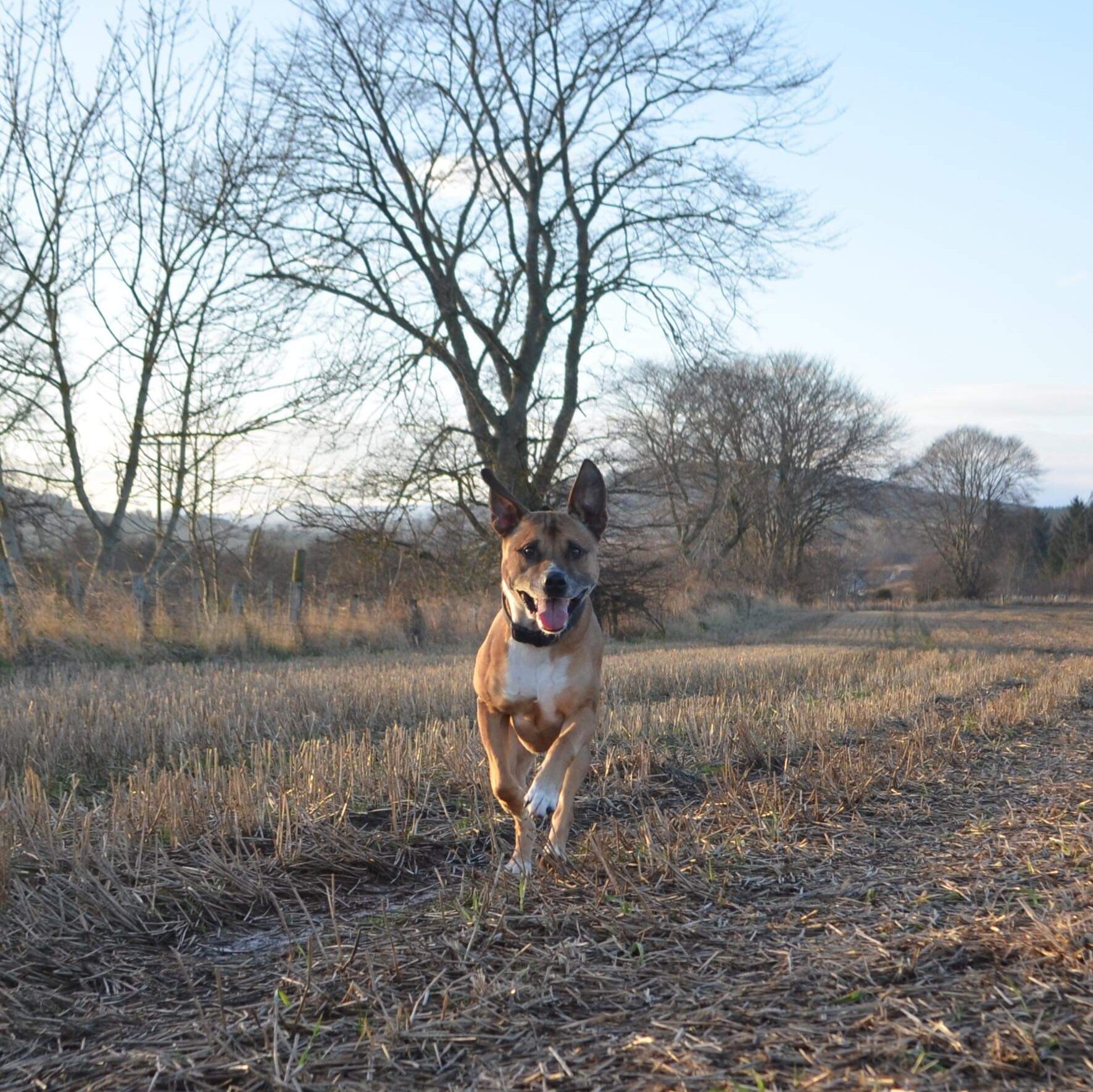
Frisbee
Play frisbee with your dog in an open area. This game will give physical exercise and mental stimulation as your dog learns to track and catch the frisbee.
Track and Find
Hide a toy or treat in a specific area of your yard and ask your dog to find it by following a scent trail. This game will use their tracking skills and give mental stimulation.
Scent Work and Nose Games
Scent work and nose games will give dogs mental stimulation and challenge their sense of smell. Games like “Find the Treat” and “Scent Work” will help dogs develop their problem solving skills and confidence. Using verbal cues and rewards, dogs will learn to follow scents and find hidden items, keep their minds active and engaged.
Find the Treat
Hide treats around the house or yard and ask your dog to sniff them out. Start with easy hiding spots and gradually increase the difficulty. This will stimulate your dog’s nose and mind.
Scent Trails
Create a scent trail using a treat or a piece of your dog’s favorite toy. Drag it along the ground and hide it at the end of the trail. Ask your dog to follow the scent to find the hidden item. This will improve your dog’s tracking skills and will give mental stimulation.
Scent Discrimination
Teach your dog to distinguish between different scents. Use various objects, each with a different scent, and hide them around the house. Reward your dog for finding the correct object based on the scent you give. This will challenge your dog’s nose and brain, advanced mental stimulation.
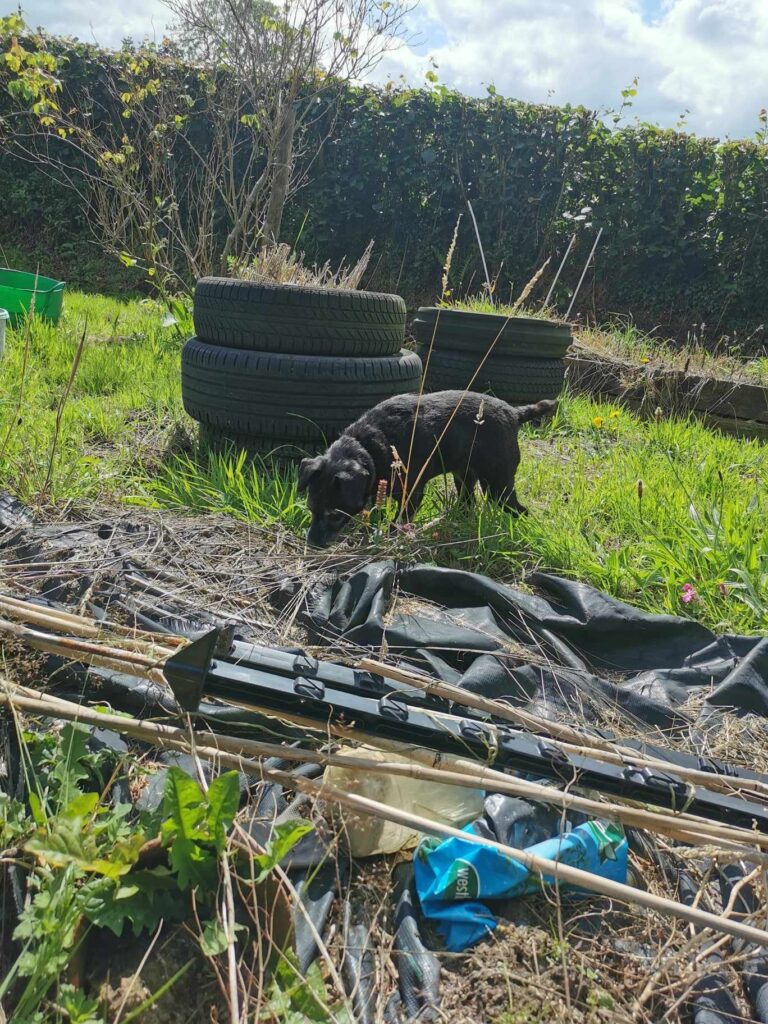
Nose Work Classes
Enroll your dog in nose work classes to further develop their scent detection skills. These classes will provide structured training and advanced scent work activities. They will also give socialization and learning in a controlled environment.
DIY Scent Work
Create DIY scent work games at home. Use cotton balls soaked in different scents like vanilla or lavender and hide them around the house. Ask your dog to find the cotton balls based on the scent.
Scent Boxes
Make scent boxes by putting different scented items in boxes with small holes. Let your dog sniff each box and find the one with the specific scent you’re targeting. This will refine their scent discrimination.
Hide and Sniff
Hide your dog’s favorite toys or treats in different areas of your home. Ask them to sniff out the hidden items. This will hone their sense of smell and give mental stimulation.
Scavenger Hunt
Create a scavenger hunt with a series of scent based clues leading to a final treat or toy. Each clue should be scented and placed in a strategic location to guide your dog to the next one. This will engage their brain and nose.
Scent Work in the Park
Do scent work in the park. Hide treats or scented items and let your dog use their nose to find them. The outdoor environment will add an extra layer of challenge and fun.
Dog Brain Games
Dog brain games can be found online or created at home using household items. Examples are puzzle toys, interactive games and scent work. These can be customized to individual dogs needs and abilities so every dog gets the mental stimulation they need.
Interactive Toys
Interactive toys like treat-dispensing balls and puzzle feeders are great for mental stimulation. Fill these toys with treats and let your dog figure out how to get to the reward. These toys will keep your dog’s brain working and can be used as a game during meal times.
Three Cups Game
The three cups game is a simple but effective brain game for dogs. Place three cups upside down in a row and hide a treat under one of them. Shuffle the cups around and ask your dog to find the treat. This will require problem solving and will keep your dog engaged.
DIY Snuffle Box
Make a DIY snuffle box using a cardboard box and crumpled paper. Hide treats in the paper and let your dog use their nose to find them. This will be a fun and interactive way for your dog to use their natural foraging instinct.
Kong Wobbler
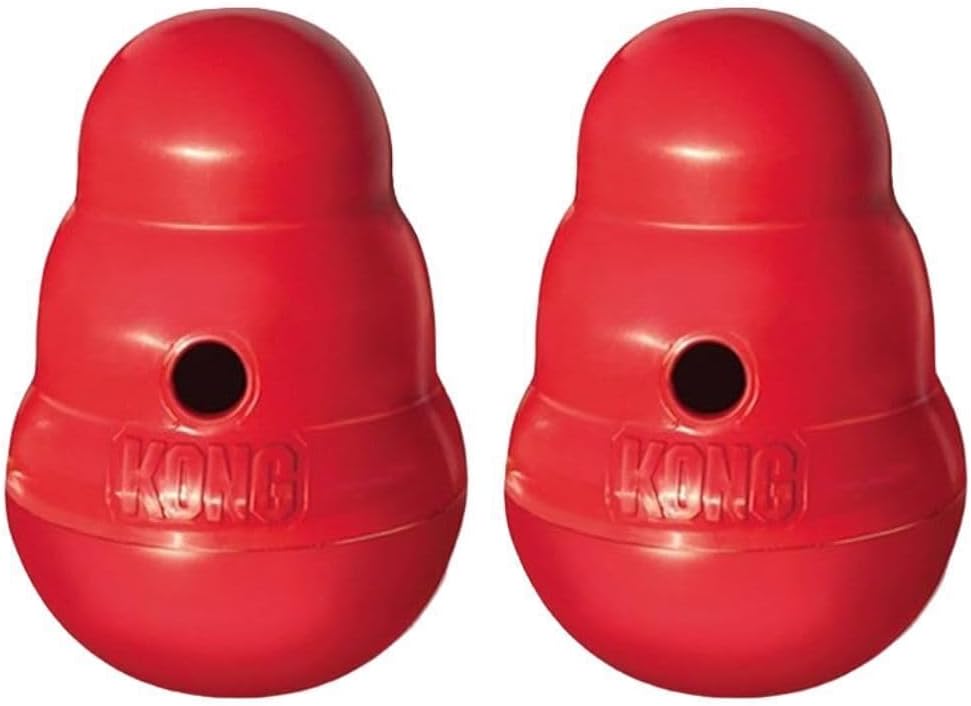
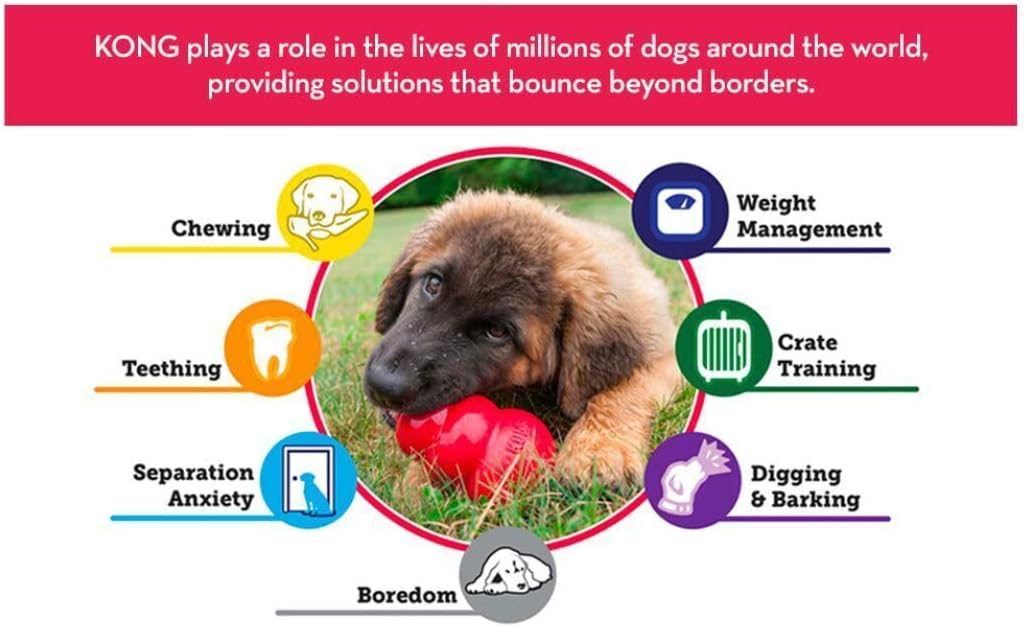
KONG Wobbler Treat Dispensing Dog Toy
Dispenses food and treats for hours of fun, prevents rapid eating, Entertaining wobble action, Twist off dispenser, Measures 6-inches tall by 4-inches wide
The Kong Wobbler is a popular treat-dispensing toy that will provide mental stimulation. Fill it with your dog’s favorite treats or kibble and let them figure out how to get the food out. The unpredictable movement of the Wobbler will keep your dog engaged.
Homemade Treat Puzzles
Make homemade treat puzzles using muffin tins and tennis balls. Place treats in some of the muffin tin cups and cover them with tennis balls. Let your dog figure out how to move the balls to get to the treats. This will require problem solving and mental stimulation.
DIY Treat Dispensers
Make your own treat dispensers using plastic bottles. Cut holes in the bottles just big enough for treats to fall out when your dog rolls or shakes the bottle. This DIY will keep your dog busy.
Hide and Seek Toys
Hide your dog’s toys in different rooms or behind furniture and ask them to find them. This will use their sense of smell and provide mental stimulation as they search for the hidden toys.
Treat-Stuffed Toys
Stuff your dog’s favorite toys with treats and freeze them for an extra challenge. Your dog will have to work to get the treats out, this will provide mental and physical stimulation.
DIY Foraging Mats
Make a foraging mat using an old towel or blanket. Hide treats in the folds and let your dog use their nose to find them. This will stimulate their natural foraging instinct and mental enrichment.
Memory Games
Play memory games with your dog by hiding treats under cups and moving them around. Ask your dog to remember where the treat is hidden. This will sharpen their memory and problem solving.
Mental Stimulation for Dogs
Mental stimulation is important for dogs’ overall health and happiness. Mental stimulation will reduce stress and anxiety in dogs.
Mental stimulation can be through games, puzzle toys and interactive activities so your dog will be happy and healthy.
Add an exercise schedule to your dog’s daily routine. This can be a mix of puzzle toys, scent work and obedience training games. A balanced schedule will give your dog’s brain a workout and reduce boredom and destructive behavior.
Engaging Walks
Turn your regular walks into an adventure by adding training games and challenges. Practice loose leash walking, obedience commands and scent work on your walks. This will give your dog physical exercise and mental stimulation and keep them focused and well behaved.
Training Sessions
Add short training sessions throughout the day for mental stimulation. Teach your dog new tricks or reinforce existing commands with positive reinforcement. These will keep your dog’s brain active and strengthen your bond.
Interactive Playtime
Set aside time each day for interactive play with your dog. Use toys that require problem solving or incorporate training commands into playtime. This will keep your dog engaged and a fun way to exercise their mind.
Environmental Enrichment
Make your dog’s environment enriched by providing many toys and rotate them regularly to keep things interesting. Include puzzle toys, interactive games and scent work activities so your dog has plenty of mental stimulation options.
Daily Tasks
Set daily tasks for your dog to solve, such as finding hidden treats or learning new commands. These will keep their brain engaged and give them a sense of achievement.
Brain Training Apps
Use brain training apps for dogs to provide structured mental exercises. These apps have many games and activities to stimulate your dog’s brain and improve their cognitive skills.
Interactive Feeders
Use interactive feeders or slow feeders to make mealtime more fun. These feeders will make your dog work for their food, provide mental stimulation and slow down their eating.
Rotate Toys
Rotate your dog’s toys regularly to keep them interested and engaged. Introduce new toys or bring out old ones to make playtime exciting and stimulating.
Interactive Games with Family
Involve your family in interactive games with your dog. Play tug of war, fetch or hide and seek with different family members to add variety and mental stimulation.
Puppies
Games for puppies is for socialization, training and mental stimulation. Examples are hide and seek, fetch and interactive toys. These can be tailored to individual puppies needs and abilities so they grow up to be well adjusted and obedient dogs.
Hide Toys
Hide your puppy’s toys around the house and encourage them to find them. This game will help develop their sense of smell and problem solving skills. Reward them with treats and praise when they find the hidden toys.
Tug of War
Play a gentle tug of war with your puppy using a soft toy. This will help teach impulse control and strengthen your bond. Make sure it’s gentle so you don’t harm their developing teeth.
Puppy Agility
Set up a mini agility course for your puppy using household items. Guide them through tunnels, over small jumps and around obstacles. This will help develop their coordination and mental and physical stimulation.
Puppy Socialization Games
Introduce your puppy to new environments, people and other dogs through socialization games. Arrange playdates with other puppies or take them to puppy classes. These will help build confidence and social skills.
Puppy Puzzle Toys
Provide puzzle toys designed for puppies. These are usually easier to manipulate and will help develop their problem solving skills. Fill them with treats to keep your puppy engaged and happy.
Puppy Fetch
Play a gentle game of fetch with a soft toy or small ball. This will provide physical exercise and develop their coordination and retrieving skills.
Interactive Feeding
Use interactive feeding methods such as treat dispensing toys to provide mental stimulation during meal times. This will make your puppy think and work for their food and keep their brain active.
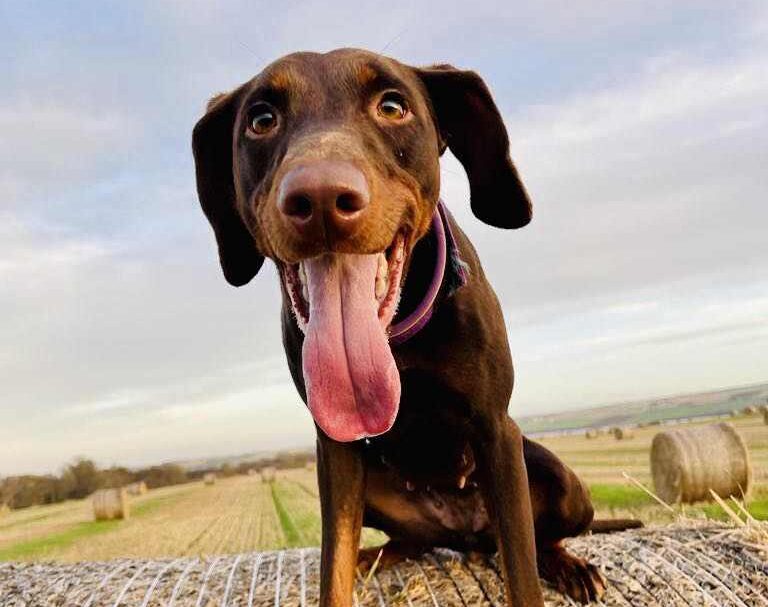
Puppy Training Classes
Enrol your puppy in training classes to learn basic commands and socialize with other puppies. These classes will provide structured learning and mental and physical stimulation.
Puppy Playdates
Arrange playdates with other puppies to socialize and play. Playing with other puppies will help your puppy learn social cues and behaviors in a controlled environment.
Gentle Hide and Seek
Play a gentle game of hide and seek with your puppy. Hide in a low distraction environment and call your puppy to find you. Reward them with treats and praise when they find you.
Old Dog New Tricks!
Adapting games for older dogs will provide stimulation and physical exercise. Examples are short walks, gentle fetch and interactive toys. Adapting games for older dogs will keep them healthy and happy.
Senior Agility
Set up a low impact agility course for your older dog using household items. Guide them through tunnels, over low jumps and around obstacles. This will help maintain their coordination and provide gentle exercise.
Take your older dog on short, easy walks and add simple challenges like sniffing out treats or practicing basic commands. This will provide gentle exercise and keep their brains active.
Play a gentle game of fetch with a soft toy or tennis ball. Keep the throws short so you don’t strain their joints. This will provide light exercise and mental stimulation so they don’t overdo it.
Use puzzle toys designed for older dogs. These are usually easier to manipulate and will provide stimulation without frustration. Fill them with treats to keep your senior dog happy.
Play a gentle game of tug of war with a soft toy. Don’t make it too strenuous so they don’t get uncomfortable. This will provide light exercise and keep their mind active.
Use interactive feeding methods such as treat dispensing toys to provide stimulation during meal times. This will make your older dog think and work for their food and keep their brain active.
Nose Work for Seniors
Do nose work with your older dog. Hide treats in easy to find places and encourage them to use their sense of smell to find the treats. This will provide stimulation and keep their nose sharp.
Gentle Training Sessions
Have short, gentle training sessions throughout the day. Teach your senior dog new tricks or reinforce existing commands with positive reinforcement. These will keep their brain active and strengthen your bond.
Comfortable Play Areas
Create comfortable play areas for your older dog with soft bedding and toys. So they can do mental and physical activities without discomfort.
Interactive Play with Family
Get family members involved in interactive play with your older dog. Playing fetch, tug of war or hide and seek with different family members will provide variety and keep them mentally stimulated.
Cognitive Enrichment
Provide cognitive enrichment activities such as puzzle toys and interactive games that will stimulate your older dog’s brain. These will maintain their cognitive function and prevent cognitive decline.
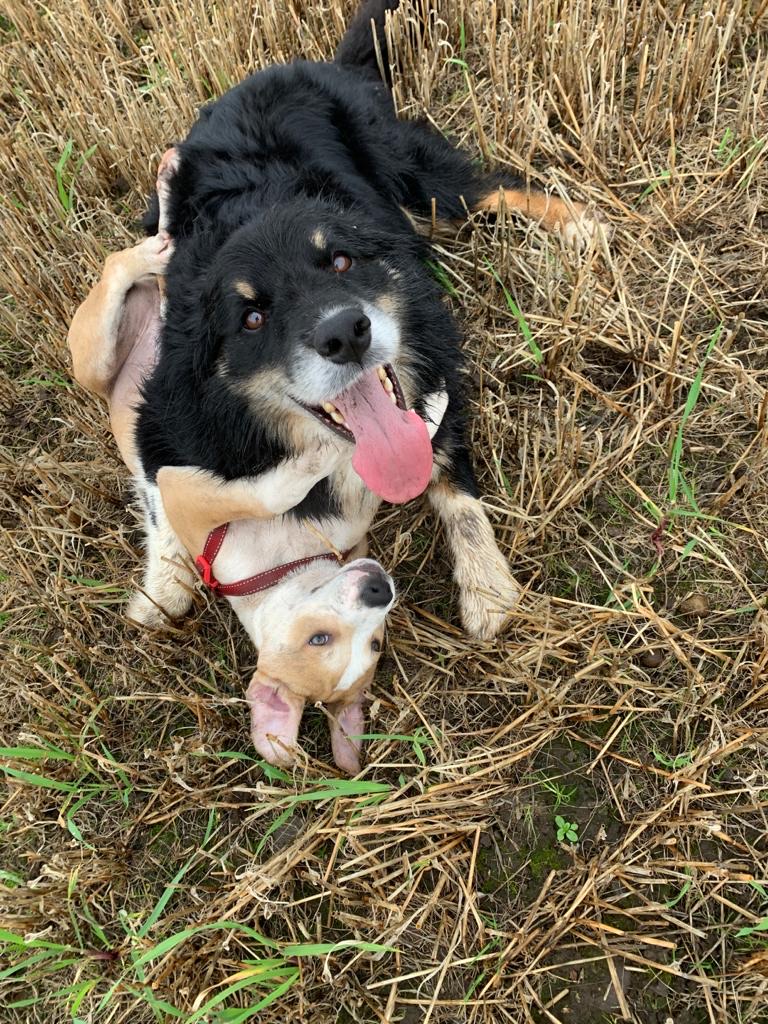
DIY Games and Activities
DIY games and activities can be made at home using household items. Examples are
hide and seek, obstacle courses and scent work.
DIY games and activities can be customized to individual dogs needs and abilities so you have endless fun and learning.
You made it to the FAQ!
Is brain training for dogs worth it?
Yes, brain training for dogs is worth it. It will provide stimulation that can prevent boredom, reduce anxiety and improve overall behaviour.
What is good mental stimulation for a dog?
Good mental stimulation for a dog is puzzle toys, hide and seek, obedience training and problem solving games.
What is the hardest thing to train a puppy?
The hardest thing to train a puppy is impulse control. Teaching them to stay calm and focused especially around distractions is hard.
What game does the puppy like the most?
The game most puppies love is playing fetch. It’s physical exercise and the thrill of the chase, so it’s a favourite.
What is the quickest way to train a puppy?
The quickest way to train a puppy is through consistent, short training sessions using high value treats as rewards to keep them engaged and motivated.
What are the 7 most important dog commands?
The 7 most important dog commands are sit, stay, down, come, heel, off and no.
What is the 1 2 3 dog training method?
The 1 2 3 dog training method is breaking down commands into 3 simple steps, so the dog can understand and follow.
What should I train my dog daily?
You should train your dog daily in basic commands, obedience training and fun tricks to keep their mind sharp and behaviour in check.
What are the 6 commands for dog training?
The 6 commands for dog training are sit, stay, come, down, heel and leave it.
What is the dog game for stimulation?
A great game for dog stimulation is the treasure hunt, where you hide treats around the house or yard for your dog to find using their superpower sense of smell.
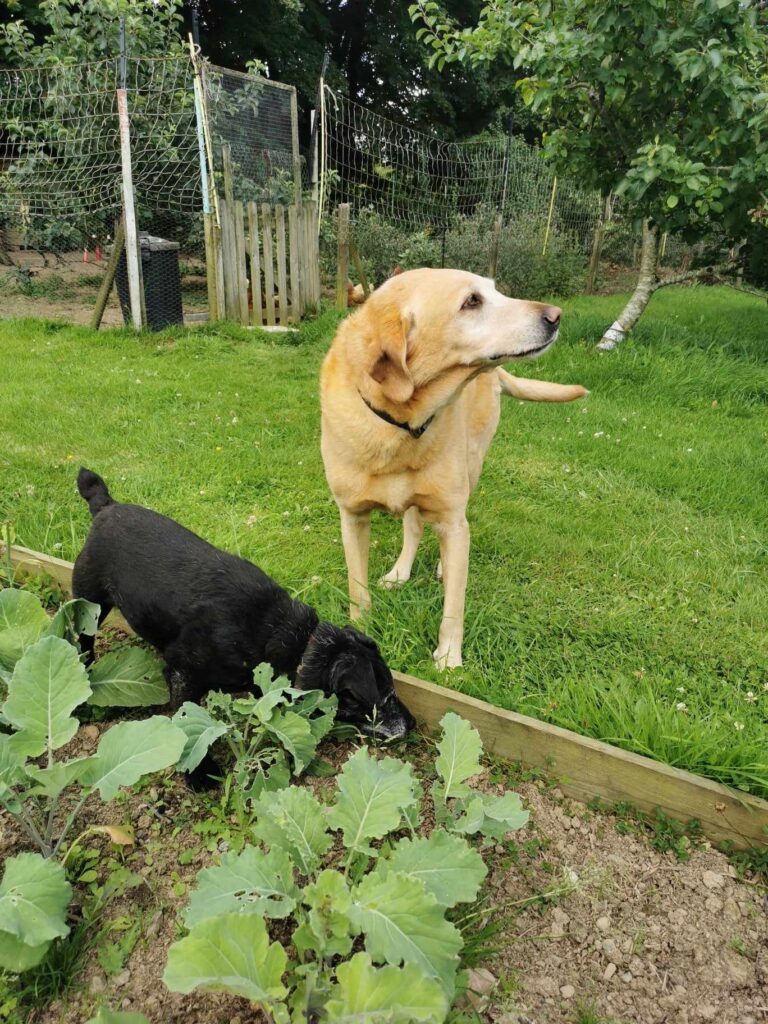
Summary
Training games are a great way to provide mental stimulation and physical exercise for your dog. From problem solving to obedience and reducing anxiety, these games are endless. Add fun games like the three cups game, fetch and treasure hunts to your daily routine to keep your dog’s brain working and behaviour in check.
Remember, a mentally stimulated dog is a happy dog. So, grab your dog’s favourite toy and start playing today!

